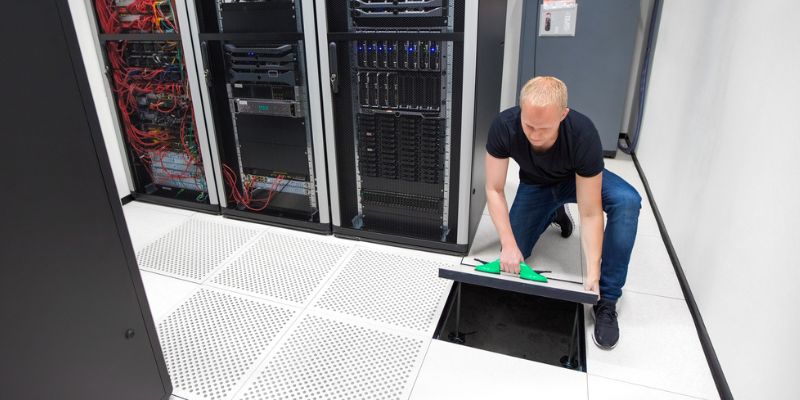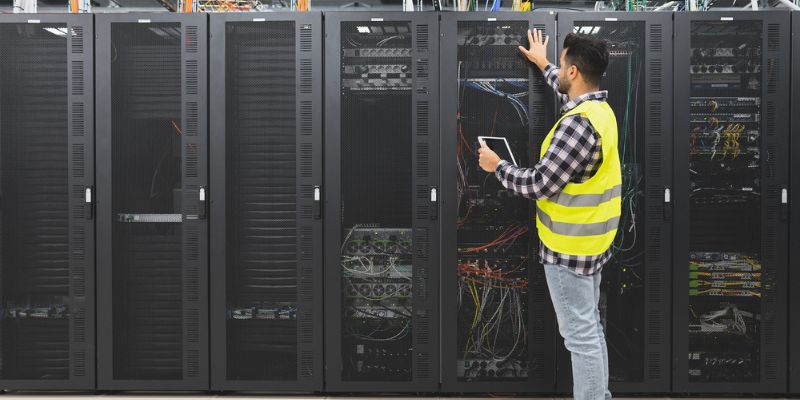Raised floors have been used in data center design for decades, but with evolving technologies and alternative cooling methods, it’s important to assess their current relevance. This guide by the team at Access Computer Floors will explain what raised floors in data centers are, highlight key advantages and considerations, compare them to modern alternatives, and discuss whether raised floors still make sense today. So if you’ve been considering making this upgrade for your data center, keep reading; you might find exactly what you need.
What is Raised Flooring for Data Centers?
A raised floor (also known as an access floor) is an elevated platform built above a building’s structural floor (typically a concrete slab) to create a hidden space (plenum) for routing cables, power, and cooling air. In data centers, this void is commonly used for underfloor air distribution (to keep the equipment ventilated through perforated floor tiles) and for running power and network cabling out of sight.
Raised flooring became an industry-wide practice in data centers by the late 19s, originally to solve issues of the time because computers used to get very hot and required much more cabling than today’s. Even as some facilities now use hard slab floors with overhead systems, raised floor systems remain popular because their benefits are timeless. Data centers still need efficient cooling and cable management capabilities, and raised floors are the perfect solution.

Key Benefits of Raised Floors in Data Centers
Raised floors offer several significant advantages for data center efficiency. Below, we’ll dive into the key benefits and how they contribute to operations and a more scalable facility:
Optimized Cooling and Airflow Management
As mentioned before, one of the primary reasons for using raised floors is to improve cooling efficiency through underfloor air distribution. The space beneath a raised floor acts as an HVAC plenum, delivering chilled air directly in front of server racks via perforated data center floor tiles. This approach facilitates hot aisle/cold aisle configurations: cold air rises through the perforated tiles in the cold aisles and is drawn through the servers, while hot air is expelled to separate hot aisles.
Streamlined Cable Management
Another major benefit of raised floors is their hidden cable management space. Power cords, network cables, and pipes can be routed neatly under the floor, keeping them out of sight and out of the way. This helps keep the main data center room less cluttered, improving airflow and accessibility.
Technicians can run cables directly under equipment rows and terminate connections exactly where needed by pulling cables up through cutouts in the floor. Unlike overhead cable trays that require ladders and ceiling supports, underfloor cabling allows staff to access wires by lifting a floor panel simply using a floor lifter; no special overhead lifts are needed. Also, with a raised floor, the data center maintenance and reconfiguration of cabling become easier and safer.
Flexibility for IT Infrastructure Growth
Raised floor systems are highly modular and scalable, supporting growth and changing requirements in a data center layout. Because the floor tiles are interchangeable, you can rearrange or install new perforated vents or solid tiles to accommodate new server equipment or hotspots.
This flexibility also extends to power and network changes because you can easily lay new cables underfloor or reroute existing ones to new rack locations. Lastly, because the underfloor space is accessible and reconfigurable, raised floors make it easier to retrofit or expand a data center.
Long-Term Cost-Efficiency
When considering costs, raised floor systems involve a higher initial investment, but they can provide long-term savings and efficiency that offset those upfront costs. Installing a raised floor means you are essentially building a “floor on top of a floor,” which adds construction expense. However, this investment can be justified by several cost efficiencies over the data center’s life, like energy savings, optimized use of space, and reduced infrastructure upgrades.
In summary, while you pay more upfront for a raised floor installation, you may reap financial benefits over time through lower cooling costs and more efficient use of space.

Raised Floors vs Alternatives in Data Centers
Due to new technological approaches, many data centers are considering alternatives to traditional raised floors. The main alternative is a hard slab floor design and other cooling and cabling strategies. Below, we built a table to illustrate how raised floors compare to these modern alternatives:
| Aspect | Raised Floors | Hard Slab / Overhead Alternatives |
| Cooling distribution | Under-floor plenum pushes chilled air through perforated tiles, enabling straightforward hot-/cold-aisle containment. | Cold air delivered from overhead ducts, rear-door heat exchangers, or in-row units can cool high-density racks with more precision, but adds ductwork/containment complexity. |
| Cabling & power management | Power whips and data cables hide under the floor; quick tile lift gives ladder-free access, and faults usually affect only one rack. | Cables/busways run overhead, and systems are often proprietary, costlier, and less flexible. One bus fault can knock out many racks, and techs need lifts to service them. |
| Floor structure & cost | Requires panels and pedestals, so the cost is higher, but it frees overhead space and can offset other infrastructure costs. | Concrete slab is the cheapest to pour, yet stronger overhead supports, taller rooms, and extra cooling gear may offset savings. |
| Emerging technologies | Optimized for air-cooling; under-floor plenum is less relevant for liquid-cooling deployments, though hybrid schemes exist. | Pairs well with liquid-cooling (direct-to-chip, immersion) or chilled-water tubes embedded in the slab. No plenums are required, simplifying future ultra-dense designs. |

Are Raised Floors Still Relevant in Modern Data Centers?
With the emergence of alternative cooling methods and the ever-increasing power density of IT equipment, a natural question arises: Are raised computer floors still relevant today? The answer is nuanced. Raised floors are still used and are the trusted standard in many data centers.
Raised server room floors are still relevant, but not universally necessary. They are likely to remain part of data center design for years to come, particularly in small to mid-sized or retrofit projects where they offer convenience and sufficient performance. However, the trend is that raised floors are becoming less common (or more likely to be used in a hybrid form) in cutting-edge large-scale data centers as more efficient and cost-effective alternatives are embraced.
The decision largely depends on the context: if your cooling needs can be met with conventional air and your densities are moderate, a raised floor is a tried-and-true solution. If you’re pushing the envelope on density or looking to minimize build costs, you might design without one.
Ready to Implement Raised Flooring in Your Data Center?
With all that you just learned, if you are leaning toward a raised floor for your data center, proper planning and execution are key to reaping the benefits, and hiring professional contractors is essential. That’s what we are here for. At Access Computer Floors, we’ve been installing raised floors nationwide for more than 40 years, and we would love to help you with your access flooring project.
You can contact us for a free quote, and if you’ve come this far and still have any doubts, we’ll be happy to help!

